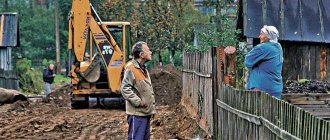Last modified: October 2021
Independent construction must be coordinated with many authorities that determine the compliance of future housing with standards. If property owners ignore the provisions of the law, big problems can arise if the construction was carried out with violations or a sale is planned. Legalization of self-construction is a mandatory procedure that will help you draw up documents for the property and have full right to dispose of it at your own discretion.
To avoid the risk of being fined a large sum or receiving an order to demolish your home, you need to go through the procedure of legalizing an unauthorized construction.
The reasons provided for by the regulatory documents for the demolition of “samostroy” in Moscow
On December 8, 2015, the Moscow Government adopted Resolution No. 829-PP “On measures to ensure the demolition of unauthorized buildings in certain areas of the city of Moscow.” It contains information on all objects, be they buildings, structures or structures, that the state has classified as unauthorized erected.
All structures that are being erected (created) within the city limits of the Moscow urban district on plots of land, and are not properly registered, are legally classified as “samostroy” and are subject to demolition. It is legally prohibited to build “self-built buildings” on public areas.
The number of objects that are subject to demolition has increased several times since the Decree was signed! At first, officials planned to demolish one hundred and four illegally built facilities. But the latest edition of the regulatory document increased the number of buildings subject to demolition to three hundred and eighty-six.
In 2021, the Moscow City Hall offered compensation in the amount of 55.5 thousand rubles, issued for each square meter of the structure, if it is dismantled independently.
It should be borne in mind that on December 11, 2013, amendments were made to Moscow Government Decree No. 819-PP. This regulatory document expands the list of structures, buildings and structures that may fall under the concept of “unauthorized construction”.
Civil legislation, based on the information set out in Article 3 of the Civil Code of the Russian Federation, consists of such regulations as the Civil Code and federal laws supplementing it. At the federal level, authorities and ministries can issue their own acts, which will contain a different interpretation of the Civil Code of the Russian Federation with some explanations. At the same time, there is a reservation that these regulatory documents must be issued within certain limits provided for by the Civil Code of the Russian Federation.
From December 11, 2013, buildings located on a certain land area that cannot in any way be classified as capital construction projects are also subject to demolition. This additional requirement established by the Resolution has significantly increased the number of illegal unauthorized constructions.
They have the right to demolish such buildings on the following two grounds:
- When registering structures and buildings as real estate objects.
- If the citizen has a certificate of state registration of property rights, drawn up in accordance with all the norms of modern legislation.
The Civil Code of the Russian Federation transfers the rights to issue acts, which include information on the norms and rules of civil rights, to the Moscow government. The executive branch, however, does not have the right to broadcast acts that expand the rules clearly established by civil law. Thus, it is illegal to introduce additional reasons for the demolition of “samostroy” into regulatory documents.
Conditions of the procedure
Regardless of the chosen method of legalizing a building, it must necessarily meet a number of requirements and urban planning standards.
The main conditions are:
- the land area on which the object is built is owned by the applicant;
- the category of the site allows the construction of real estate on it;
- the construction site should not violate the rights and interests of unauthorized citizens, or threaten their health or life;
- State and municipal authorities have no claims to the building.
If part or at least one of the requirements is not met, the issue will most likely be refused until the shortcomings are eliminated. If the violations are considered particularly severe, the structure will be destroyed.
One more point is important. If the issue is successfully resolved and the unauthorized construction is legalized, the tax for the last 3 years will be recalculated. If the plot has been owned for more than 10 years, contributions can be accrued for this entire period.
Arbitrage practice
In February 2021, the first involuntary demolition of objects was carried out by order of higher authorities. These buildings were included in the list published in Resolution No. 829-PP and 819-PP. Through the court, it was possible to remove from the list objects whose legal ownership had been proven, but in fact they had already been demolished.
All citizens interested in this case defended their rights through the Moscow Arbitration Court and through the Moscow City Court. A court case was opened to consider the clause of the Appendix and classify it as contrary to the norms of Russian legislation. In addition, the owners insisted on collecting damages incurred.
As a result, the Supreme Court of the Russian Federation declared illegal the issued Decree of the Moscow Government regarding the demolition of illegal objects. Some complaints remained unsatisfied.
Judicial practice on this part of the issue has been collected in several sources, which you can familiarize yourself with. Examples of cases are presented in the following instances:
- Arbitration court. Case No. A40-254041/2016, A40-182602/2017, A40-53919/2018.
- Court of general jurisdiction. Case No. 33a-3206/2016, 33a-3035/2016, 33a-12020/2016.
- Supreme Court of the Russian Federation. Case No. 5-APG17-147.
Objects included in the list are subject to exclusion by administrative decision through the consideration of the MGK (former GZK). This happens through the approval of a new regulatory document challenging the existing Resolution. In judicial practice, there are also cases where it is through a lawsuit that it is possible to achieve a positive decision to invalidate Resolution No. 819 in terms of including certain structures on the list.
To substantiate the stated position, the Supreme Court of the Russian Federation provided a reference to paragraph 26 of Resolution No. 10/22 of April 29, 2010 and attached an explanation to this paragraph. It stipulates that if a citizen does not have a construction permit in hand, then this is not yet a basis for the demolition of the structure he has built or dismantled. Thus, a permit may be absent, and the construction site may be recognized as legal in the case where ownership of the object is recognized.
It is important to know that the existing registration of ownership of an object does not guarantee its legal construction. In this case, the mandatory condition is that the court legally establishes the circumstances that recognize the construction as illegal.
If there is a requirement to recognize the normative act on demolition as invalid, then to consider the case the judge pays attention to the following circumstances:
- The object must be registered as a right. This procedure must be formalized in accordance with established legislation.
- There should not be a document indicating the issuance of the building permit itself.
Types of unauthorized buildings
According to the law, unauthorized structures are divided into two types:
1st type
When the owner (tenant) of a plot has made unauthorized construction of a property without having permits.
Most often these are residential buildings on personal plots, as well as small objects built on lands, for some reason, without proper supervision by the authorities, as well as small stalls, kiosks, shops built without appropriate documentation.
The first lawsuit has been filed with the ECHR, refuting the legality of the demolition of objects that are recognized as unauthorized construction
On 02/09/2016, a complaint was filed with the European Court of Human Rights from Sozidanie LLC under case number No. 71215/17. The claim was accepted for consideration in the case of illegal actions regarding the demolition of some unauthorized buildings. The complaint contained an indication of a violation of the law and the use of illegal actions in relation to existing facilities. This claim was satisfied in terms of recognition of property rights legally by a court decision, but the demolition was still carried out, and no compensation was received for the damage caused.
Is there a chance to legalize squatting administratively?
Unauthorized buildings erected or reconstructed may comply with all applicable fire safety standards and regulations. They can fully comply with all civil law requirements. At the same time, they can also be completely safe during their operation, and also not pose a threat to the health and life of the population.
According to the legislation of the Russian Federation, there is a good reason for crossing out an object from their list in the absence of any one document: a reconstruction permit or a construction permit. That is why legalizing unauthorized buildings on your own is very expensive in our time. At the same time, the citizen spends a lot of time settling formal nuances. The most offensive thing is when it is not possible to legalize self-construction, despite all the attempts made.
Improved legislative acts legalized on the territory of Moscow have opened up a new level of possibilities for assessing unauthorized buildings. This served as a starting point for the beginning of the legalization of self-construction with their preservation. This is achieved by drawing up decisions of an administrative nature.
We will legalize a turnkey house
This is not the first year on the market of providing this type of service. The procedure for legitimizing a house follows the following algorithm:
- you come to our office for an initial, free consultation with a specialist;
- during the conversation, the expert examines the documents that the client has in his hands, assesses the situation and the possibilities of solving it;
- After a thorough analysis, it is determined how valid and complete the documentation package is. If there is no document, the specialist will order it independently from the appropriate authority;
- a set of documentation is being formed that can be submitted to Rosreestr without the possibility of refusal of registration;
- we will send the papers to the registration agency ourselves;
- The review process will be monitored.
At the final stage, the client receives a certificate of ownership and registration.
Legal status of the Civil Land Contract
According to Art. 23 of the Moscow City Law of February 20, 2006 No. 65, the established Urban Planning Commission promptly makes decisions when the following list of questions is received:
- relations with land shares;
- urban planning activities;
- activities related to investments;
- the direct process of construction of objects;
- reconstruction of existing capital construction projects;
- carrying out work to maintain the integrity and preservation of immovable objects of cultural heritage.
Executive authorities accept special instructions signed by authorized secretaries. Decisions of the Commission are subject to formalization in protocols. They come into force immediately after publication. At the same moment, they confirm and prove the authority of the persons responsible for the decision made.
The principle of activity of the SLC, its powers and legal status are regulated in the Decree of the Moscow Government dated November 16, 2010 No. 1019-PP.
How to legalize self-construction through the State Land Construction Committee?
In order to legalize unauthorized construction in the prescribed manner through the State Land Lands Committee, it is necessary to go through the following steps:
- The corresponding application is sent to the State Inspectorate for Control over the Use of Real Estate Objects of the City of Moscow. The inspection collects all the necessary paperwork.
- The State Land Committee is holding a meeting. It examines the details of the case, identifies the circumstances and collects the evidence base.
- Drawing up a conclusion by the State Inspectorate. Here, if necessary, the fine that the loser of the case will have to pay is calculated.
- If a positive decision is made, a document is drawn up confirming the right to carry out reconstruction or construction of the object in question.
- An extract is issued, which justifies the advisability of preserving the object within the previous established boundaries.
- Issuance of permission to put the facility into operation.
- Carrying out registration of rights in the relevant department of Rosreestr.
Additional approvals
Additional approvals are required if the premises have been redeveloped or reconstructed after construction.
To do this, you need to send a request to the appropriate authorities in order to receive notification of redevelopment/reconstruction.
There have also been changes in legislation. If previously it was enough to attach a sketch to the technical plan and obtain permission, now before issuing the paper, a commission must visit the site. She draws up and signs a certificate of compliance, and only after that the person receives title documents.
Another innovation: if previously redevelopment in a new house could be carried out only after the property was registered in the cadastral register, now these processes can be combined, which significantly reduces the time.
The approval process is quite complicated - you need to put in a lot of effort and spend a lot of time going through the authorities.
Often modern people simply do not have time for this. We, the experts, will help you: we will take care of creating a registration certificate, collect all the necessary certificates and approvals for you, collect a full package of documents, and so on.
How is an object removed from the list?
Objects are subject to exclusion from the lists that are published in Resolution No. 819-PP, if all stages of verification are followed and the commission makes a positive decision. At the same time, all the conditions of the parties must be met and the existing penalties must be paid.
A separate clause of the State Land Code describes the procedure for the mandatory exclusion of objects from the list, which is carried out by officials specially appointed for these purposes. All questions regarding the implementation of issues of removing objects from the list are carried out, as practice shows, within 30 working days.
It happens that when objects are removed from the list, the city files lawsuits against the owners, who claim that their objects are unauthorized buildings and are subject to demolition. In this case, the city, when providing an opposing decision to the commission, is obliged to immediately withdraw all existing claims that contradict official documents. All information about the exclusion of certain unauthorized buildings must be included in a separate paragraph of the Civil Land Code protocol.
If an interested party fails to fulfill the obligations assumed by him, for example, passing an examination or paying penalties, the Protocol is immediately subject to cancellation!











